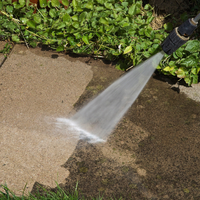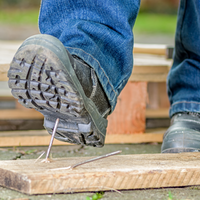Jigsaws are primarily used to make curved, intricate cuts in wood, but can also cut through a number of other materials such as plastic, sheet metal and ceramic tile.
Although jigsaws excel at making curved cuts, they can also be used to make plunge cuts, straight cuts and bevel cuts.
Jigsaws are best used for cutting shapes and curves in wood with its narrow blade, which is attached to the tool's body by a spring-loaded clamp at the front. Jigsaws are much more delicate than other powered saws and their thin blades can be fitted into tight spaces and follow a curved line with ease.
In addition to the shape of their blade, jigsaws are not very heavy so they are easy to manoeuvre and guide along stencilled designs.Jigsaws are useful for cutting through wood or metal, and enable you to make a variety of cuts, from straight edges, to rounded corners, to cuts that start within the material. This tutorial will go over how to safely set up and use a jigsaw for basic cuts.
HOW A JIGSAW WORKS
A Jigsaw works by attaching a blade accessory to the tool. There are various types of blades in the market. Older jigsaws require a blade to be screwed into the tool. But since Bosch introduced the first tool-free blade change system, most manufacturers now offer a similar setup allowing a quick and tool-free blade change.
There are T-shank blades and U-shank blades available in the accessory market. T-Shank blades are the industry-standard professional interface that provides a longer life and a tighter fit from the blade to the tool. Tooth design is important for the performance of a blade. The tooth spacing, tooth shape, and cutting angle are important in providing speed, cleanliness of cuts, and optimal performance. A side set and ground tooth is designed for clean and fast cuts in wood and plastics. Wavy set and milled teeth will cut most metals as well as plastics. A side set and milled tooth works with fast and rougher cuts in wood and plastics. A ground and taper ground tooth is for very precise, fine and clean cuts in wood. There is also reduced-kerf carbide and diamond grit edges for fast cutting in hard materials.
HOW TO USE A JIGSAW
1. Select the Right Blade
The blade of your jigsaw depends on the type of material you intend to cut. If you are cutting wood, a wood blade will enable a faster cut. If you are cutting metal, a metal blade with 21-24 teeth per inch is ideal. The blade type is evident in how fine the teeth are, or the label on the blade's box.
2. Set Up the Jigsaw
Start by putting the blade into the jigsaw, but first, make sure the saw is unplugged. Some jigsaws have bolts that need to be loosened with an allen wrench to change the blade. Newer jigsaws have a black lever that loosens the grip on the blade when pulled down, which enables you to put a new blade in. Make sure the blade is facing the right direction (the teeth of the blade are facing towards the front of the jigsaw), and that the end is securely gripped by the jigsaw when you release the black lever.
3. Set Up Material
Make sure you have properly marked where you want to cut in your material. If you need a square and even cut, a T-square will help to draw a square straight line from the end of the material. If the cut does not need to be square, still mark the shape you are going to cut out with pencil on the material. While jigsaws can cut curves, make sure none of the curves are too tight; going around very sharp bends has the potential to bend the blade. Whatever material you are cutting must be securely clamped to a table, with enough clearance so that the jigsaw does not run into any clamps or the table itself. If you are cutting one big piece of wood into two, and having the edge hang off of the table is too much, you can push two tables close to each other and see the long cut between them. Both sides must still be clamped down. For smaller cuts, it is fine to let the end of the wood hang off of the table. Just make sure to leave enough space for the foot of the jigsaw to pass by the clamps without forcing the saw to run off track.
4. Cutting the Material
When setting the jigsaw up to cut, make sure the foot of the jigsaw is pressed flat against the material. Also make sure that the blade is not touching the material before you pull the trigger. Once you have lined up the blade with your cut, pull the trigger and let the blade speed up. Once at full speed, slowly move the jigsaw forward and let the blade cut into the material. Apply some forward pressure but do not force the saw to go too fast. It will naturally cut through the material, and pushing too hard can cause the blade to recoil or break, in addition to possibly damaging the material. Make sure you do not let the blade stop before completely going through the material.
If at some point in the middle of your cut the blade is forced to stop, let go of the trigger and gently try to pull it out, either straight up or through the already made cut. The blade might stop if you are cutting with the foot at an angle, if your curve is too sharp, or if you are moving too fast.
5. Clean up
Once you are done cutting, make sure to sand all of the edges of your material to avoid any splinters. Depending on the size and material, this can be done with an orbital sander, a belt sander, or a file.














